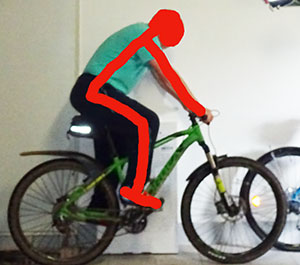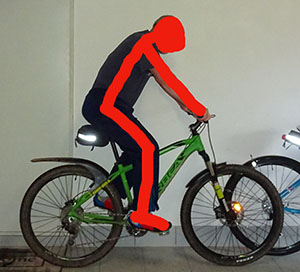How to raise mountain bike handlebar height — for spine and back problems — an after neurosurgery report
© 2016 Peter Free
21 June 2016 — Revised 22 July, 03 August 2016
About this revision
I originally posed most of this blurb on 21 June 2016. I had to revise it a month later, when I lowered my bike seat and discovered that the 8 to 9 centimeter rise that I had installed had become dangerous.
Unexpected terrain and further fiddling turned what I thought was a good idea into a noticeably bad one.
I should also point out that I often ride with a higher seat — than most people with my leg length do
Because of this, I can get away with more rise than someone whose seat begins lower relative to the handlebars.
For people with back and spine issues . . .
Raising a cross country geometry mountain bike’s handlebar height can make a substantial difference. But going too far with it will probably get you hurt in other ways.
In my case
After spinal neurosurgery, a five-minute ride on my Cannondale CAAD 10 persuaded me that I would be asking for a wheel chair, if I continued that kind of stretched out reaching. No more race style road biking for me.
The position on my hardtail mountain bike was less extreme. But it was still too close to ripping the scar tissue that is the only thing keeping the repair in place.
Compromising with Age’s creakiness
Pertinent to this handlebar fix as a way to cope with decrepitude — and possibly with regard to your own physical condition — frequent injuries, neural issues and arthritis remind me that I no longer have a rubber chicken physique. Older bodies pay when spills occur.
Yet I remain over-exuberant in what I try to get away with. Surgeons frown when I address what I anticipate doing after the patch process. I have trouble balancing fun with sensible caution.
There are some things I have done that look foolish, even to me, in retrospect. Take the time I ran from wasps and jumped a ditch, just after a total hip replacement. And then, having broken the implant loose from the femur doing that, I decided that inline skating might keep me in shape while it healed. Slalom skating up and down a hill. Two shoulder surgeries and two years of rehab later, I still can’t hold anything much heavier than a feather over my head on the left side.
That might not have been a good idea, comes up frequently. My wife “raises her voice” at me a lot.
For example, one section I ride is deceptively unpleasant. Loose and fixed cobble-sized stones of various shapes, water and mud holes. Slight downslope. Front and rear wheels have come off twice come on this patch. It seems as if it should be easy. Wouldn’t a younger rider just dash through?
Stubborn clinging keeps some of us twiddling with aspects of activities that we probably should give up. But what if a handlebar adjustment could keep us in the game?
30 degree stem plus a 50 mm riser handlebar — too much, as it turned out
The bike in the pictures is a 2015 Orbea MX 10. It has cross country geometry. See an explanation here.

The above picture shows the previous 80 millimeter ODI horizontal stem combined with a 2015 Chromag carbon Cutlass handlebar. The 750 millimeter wide Cutlass bar has a 5 degree upsweep, an 8 degree backsweep and an 18 mm rise.

The second picture shows a 90 millimeter Ritchie Pro 30 degree stem combined with Deity’s Top Soil aluminum handlebar. The 735 mm wide Top Soil has a 5 degree upsweep, a 9 degree backsweep and a 50 mm rise.
This combination raises the handlebar about 8 to 9 centimeters. That is close to 3.5 inches.
Initially, this worked better than I had anticipated
I was a little surprised that the higher handlebar did not impact going up steep hills very much. I had to be only slightly more conscious of where my weight was.
Part of this may be attributed to the fact that I intentionally lengthened the stem by 10 mm (from the original 80 to 90 mm). I was afraid that staying with 80 mm might put my center of gravity too far back with the higher rise bar.
For comparison to the hills that you ride, “mine” are steep enough that — under wet conditions — the rear wheel always slips. Even when it is dry, I have to modulate power to avoid this.
Similarly, if I am not leaning noticeably forward over the handlebar, I will flip backwards. The higher handlebar, however, did not change these characteristics enough to worry about.
On the positive end, the higher setup makes going downhill less problematic. That is good for me because aged brittleness lends itself to catastrophic falls that I would like to avoid.
And then I slightly lowered the bike seat — and what had been manageable was not anymore
I lowered the seat about 1.2 centimeters to see whether I could generate more power going up hills.
I realized that this would effectively increase bar rise from the 8 or 9 centimeters — that I had started with after the first modification — to 9 or 10.
I did not think this small change would make a big difference.
Boy, was I wrong
The first day out, I noticed that I had to really concentrate to avoid side to side wheel wobble and front wheel lifting going up my usual steep hills. I foolishly discounted this feeling, thinking that I was tired.
The second day, I went up the one of the nastier climbs in my area. It is not quite as steep as the other hills I ride. But it is loosely covered in gravel and golf ball to larger sized rocks. In dry weather, many of these skitter across the hard ground.
These stones aren’t round. Sometimes they act like wheel stops. When I’m going slowly, the front wheel turns to one side and my momentum drops.
On the day in question, I came into this hill in too high a gear. I had forgotten how often uncooperative stones slow my forward progress. When I attempt to power over them — sitting or standing — the rear wheel spins. Which does nothing to regain lost velocity.
It quickly became clear that the 8 to 9 centimeter handlebar rise, compounded by my lowered seat, had reduced front wheel control. A surly rock stopped my up-hill progress unexpectedly, and sideways I fell. As usual (for me), this happened so quickly that I could not get out of the clipless pedals.
And— equally naturally — this all happened in full view of everyone whizzing by on the incidentally adjacent Autobahn.
I chewed humiliation while pushing the bike to a point where I could get back on it, without repeating the dismal performance.
Other negatives
Aluminum instead of carbon
The aluminum bar’s vibration aggravates nerve damage in my arms. I may experiment with replacing the Top Soil bar with the carbon handlebar that I removed. The reduction in vibration may outweigh the benefit of rise.
Occasional awkwardness in another situation
The rise in bar height makes pushing the bike up very steep hills and through brush and logging clutter clumsy. I am better off putting one hand on the top tube and the other behind the seat. If I don’t, the front wheel frequently slips sideways. This gets tiring when bushwhacking.
The moral? — Rise works to protect the spine, but . . . be careful how much you dial in
Excess teaches us lessons.
After the tumble, I replaced the 30 degree Ritchie stem with the flatter one that had come with the bike. This dropped the total rise by about 4 to 4.5 centimeters.
The change did the trick. I managed to get up the troublesome hill, without toppling over due to lack of front wheel control.
That said, even the remaining 4 centimeters of rise (due to the Deity handlebar compared to the Chromag) is enough to reduce control on this stonily loose, steep hill.
 PeteFree.com
PeteFree.com